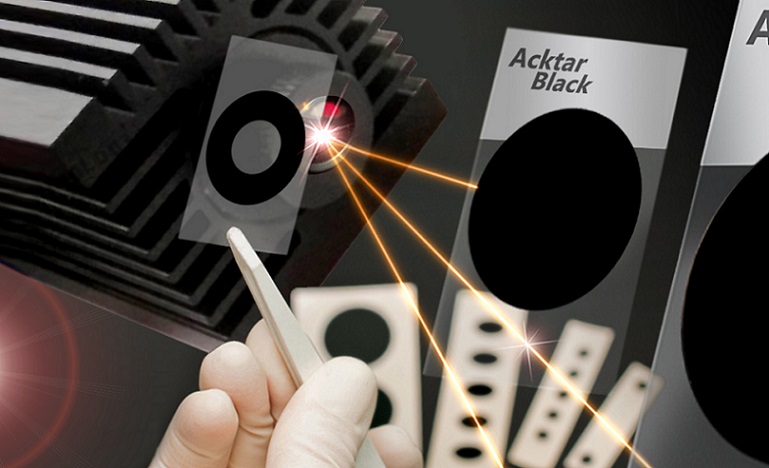Infrared Spectroscopy (IRS) – A Molecular Overview

What is infrared spectroscopy?
infrared spectroscopy (also known as IR spectroscopy, vibrational spectroscopy, or [henceforth] – IRS) is the measurement of infrared radiation as it interacts with matter by absorption, emission, or reflection.
Uses of IRS
The most common uses of IRS are the studying and identifying of chemical substances or functional groups in solid, liquid, or gaseous forms. IRS is among the best analytic techniques available to food scientists and industry personnel. It’s primarily used by chemists for structural elucidation and compound identification. The analysis is used to determine various chemical functional groups present in a sample. Different functional groups absorb characteristic frequencies of IR radiation. IR spectrometers can accept a wide range of sample types (gases, liquids and solids) using various sampling accessories.

Black coated component for SNR improvement at Raman Spectroscopy system.
Acktar’s IRS
The operational utility of Infrared Spectroscopy (IRS) depends upon the quality of the optics and upon their ability to separate signal from noise. It is in this area that Acktar light-absorbing black coatings make their critical contribution. As in all areas of very high-quality optics stray light suppression is critical and Acktar coatings are best-in-the-industry.
The Advantages
IRS can provide information in the quickest, most cost-effective and completely nondestructive way, regarding quality and quantity.
- It requires no use of any polluting chemicals.
- Its simplicity allows even minimally-trained personnel to carry it out.
- It is proven to be a highly efficient tool for quality control and assurance in a myriad of separate industrial settings, suitable for various applications under steady process on-line conditions.
- The method is constantly widening horizons in terms of the detection of adulteration and authentication of countless food products.
- Another key benefit that IRS provides is a delicate probe for specific functional groups in polymers.
- IRS relentlessly monitors interactions of chemical molecules with IR light and the subsequent vibrations. This offers many things to analysts- including speed, convenience, reliability, and accuracy – all while reducing their cost, time, and labor tremendously.
Revolutionizing the Food Industry
The adoption of the IRS techniques for food and dairy analysis might be relatively new, however, the number of applications using it is multiplying at an astounding pace.
As awareness increases, demand increases for better instrumentation, miniaturization and portability – enabling on-site analysis for immediate results.
In the universe of dairy analysis, applications of IRS encompass two main areas: the quantification of concentrations and quality parameters; and testing of purity, identity, and adulteration.

Coating type: Acktar Magic Black TM
Additional molecular vibrational spectroscopy methods
- A vital one is Fourier Transform Infrared (FTIR) Spectroscopy. This method, still in the realm of IRS, is a measurement technique that allows one to record IR spectra.
- There are various types of IR Microscopyout there.
- Another one is Raman Spectroscopy. This technique involves an inelastic scattering process, and within this process just a portion of an incident photon’s energy is absorbed by the molecule, while whatever part remains scatters and gets detected.
- Another method is Electron Energy Loss Spectroscopy (EELS). It resembles Raman Spectroscopy, but instead of photons- it deals with electrons. It’s more useful for studying vibrations of molecules adsorbed on solid surfaces.
- Lately, High-Resolution EELS (HREELS) became an additional technique for performing vibrational spectroscopy in a transmission electron microscope (TEM). Although the spatial resolution of HREELS is very high, the bands are extremely broad compared to other techniques.
- Last but not least – Computational IR Microscopy. This method uses computer simulations, combined with normal mode analysis – helping the calculation of theoretical frequencies of molecules.
The Chronicles of IRS Developments Overtime
- All the way back in the late 1940s, the first IRS instrumentations became available.
- Only in the 1950s, the earliest applications of IRS were reported.
- It took more than a decade, not until the 1960s – that IRS was adapted for use in the analysis of food samples.
- However, only the introduction of Fourier Transform (FT) instruments resulted in the most significant advancement in the field – making IRS even more rapid, reproducible, and sensitive.
- Even nowadays, numerous researchers are still actively working on further extending applications of the IRS techniques for both industrial uses as well as dairy research. The crucial focus of their research is the use of IRS to comprehend changes in dairy products, ingredients, and microbial population during processing- with the overall objective of optimization, improvement, and standardization of product quality and safety.
While several applications remain unexplored to this day, and numerous ideas are still only in the development phase- the field of IRS offers exciting research opportunities.

